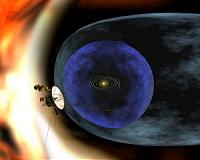 |
Pasadena CA (JPL) Oct 30, 2010 As NASA's two Voyager spacecraft hurtle towards the edge of our solar system, a new project manager will shepherd the spacecraft into this unexplored territory: Suzanne Dodd, whose first job at NASA's Jet Propulsion Laboratory in Pasadena, Calif., involved sequencing science and engineering commands for Voyager 1 and 2 in 1984. "I'm thrilled to re-join a pioneering mission that set up adventures for so many other spacecraft to follow," Dodd said. "There will be more firsts to come as we gather unique data once the spacecraft reach interstellar space. There isn't a single mission currently on the books that will be doing what Voyager is doing." The Voyager 2 spacecraft, launched on Aug. 20, 1977, is about 14 billion kilometers (9 billion miles) away from the sun. It is the longest continuously operating NASA spacecraft. The Voyager 1 spacecraft, launched on Sept. 5, 1977, is about 17 billion kilometers (11 billion miles) away from the sun. It is the most distant active spacecraft. In four to six years, Voyager 1 is expected to cross beyond the heliosheath, the outer layer of the bubble around our solar system that is composed of ionized atoms streaming outward from our sun. Voyager 2 is expected to cross that boundary several years later. Once beyond our heliosheath, the two Voyager spacecraft will begin exploring the interstellar medium, which fills the space between stars. When Dodd started on Voyager, Voyager 2 was on its way to Uranus. She stayed with the mission until Voyager 2 completed its closest approach to Neptune. No other spacecraft have visited these two outer planets. Dodd still keeps a rolled-up sheet of vellum in her cabinet that shows the timeline of commands communicated to the spacecraft during its closest approach to Neptune on Aug. 25, 1989. The encounter with our seventh planet revealed the Great Dark Spot, a giant storm roiling Neptune's atmosphere, and geysers erupting from pinkish-hued nitrogen ice that forms the polar cap of Neptune's moon Triton. After leaving Voyager in October 1989, Dodd moved on to other JPL projects, including NASA's Cassini mission to Saturn. She left JPL in 1999 to work at the Spitzer Science Center, which processes data from NASA's Spitzer Space Telescope, and, later, the Infrared Processing and Analysis Center, which archives infrared astronomy data from many sources. Dodd eventually managed both those centers, which are based at the California Institute of Technology in Pasadena. "Coming back to Voyager is like re-learning a language you knew as a kid, but never spoke as an adult," said Dodd. "I'm excited to be immersed in the details again." Dodd was also recently named the Spitzer Space Telescope's new project manager. Dodd says the main challenge with Voyager now is to work within the boundaries of the spacecrafts' limited resources to make sure they collect the long-anticipated interstellar data. For example, Voyager's radioisotope power generators, which use heat from the decay of plutonium to produce electricity, have enabled the spacecraft to operate for this extended period of time, so far away from the sun. But the power, as expected, decays over time. While supplies are expected to last through 2020, Dodd and the operations team will eventually have to turn off some instruments to manage the power resources. "My job is to make sure the two spacecraft stay healthy and mobile," she said. Dodd is a native of Gig Harbor, Wash., a town outside of Tacoma. She graduated with a bachelors of arts degree in math from Whitman College in Walla Walla, Wash., and a bachelors of science degree in mechanical engineering from Caltech. She also holds a masters degree in aerospace engineering from the University of Southern California in Los Angeles. Nine Voyager project managers preceded Dodd: H.M. "Bud" Schurmeier (1972-76), John Casani (1976-77), Robert Parks (1978-79), Raymond Heacock (1979-81), Esker Davis (1981-82), Richard Laeser (1982-86), Norman Haynes (1987-89), George Textor (1989-97) and Ed Massey (1998 to 2010). Edward C. Stone is the Voyager project scientist. The Voyagers were built by JPL, which continues to operate both spacecraft. Caltech manages JPL for NASA.
Share This Article With Planet Earth
Related Links Voyager at JPL Space Tourism, Space Transport and Space Exploration News
 Voyager 2 At 12,000 Days
Voyager 2 At 12,000 DaysPasadena CA (JPL) Jun 29, 2010 NASA's plucky Voyager 2 spacecraft has hit a long-haul operations milestone - operating continuously for 12,000 days. For nearly 33 years, the venerable spacecraft has been returning data about the giant outer planets, and the characteristics and interaction of solar wind between and beyond the planets. Among its many findings, Voyager 2 discovered Neptune's Great Dark Spot and its 450-met ... read more |
|
| The content herein, unless otherwise known to be public domain, are Copyright 1995-2010 - SpaceDaily. AFP and UPI Wire Stories are copyright Agence France-Presse and United Press International. ESA Portal Reports are copyright European Space Agency. All NASA sourced material is public domain. Additional copyrights may apply in whole or part to other bona fide parties. Advertising does not imply endorsement,agreement or approval of any opinions, statements or information provided by SpaceDaily on any Web page published or hosted by SpaceDaily. Privacy Statement |